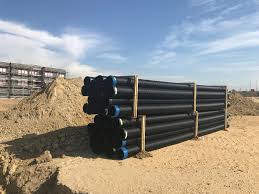Nov . 25, 2024 12:01 Back to list
wholesale pvc pipe vs ppr pipe
Wholesale PVC Pipe vs. PPR Pipe A Comparative Analysis
When it comes to plumbing and piping solutions, two materials have gained considerable attention PVC (Polyvinyl Chloride) and PPR (Polypropylene Random Copolymer). Both are widely used in various applications, but their characteristics, functions, and market dynamics differ significantly. This article explores the key differences between wholesale PVC pipes and PPR pipes to help buyers make informed decisions.
Material Composition
PVC pipes are made from a plastic polymer known for its durability and resistance to corrosion. They come in a rigid form and are great for a variety of drainage, waste, and vent systems. PVC pipes tend to be UV resistant, preventing degradation from sunlight exposure, making them suitable for outdoor applications.
On the other hand, PPR pipes are created from a different type of plastic — polypropylene. PPR is recognized for its strength and flexibility, and its resistance to high temperatures and pressures makes it an excellent option for hot and cold water transport. Moreover, PPR does not harbor bacteria, which is crucial for potable water applications.
Cost Comparison
Price is always a significant factor when making supply decisions. Generally speaking, wholesale PVC pipes tend to be less expensive than their PPR counterparts. This price difference can be attributed to the manufacturing processes and the widespread availability of PVC materials. For contractors or businesses looking for cost-effective solutions for large projects, PVC might initially appear as the better option.
However, while PPR pipes may have a higher upfront cost, they often offer long-term savings due to their durability and longevity. PPR pipes can last for decades without needing repairs or replacements, which can outweigh the initial investment over time.
Installation Process
Ease of installation is another essential aspect to consider. PVC pipes are relatively easy to work with and typically require solvent welding for joint connections. They are lightweight, making handling manageable for laborers on-site. However, the installation process might necessitate specific glues and adhesives that can emit fumes, requiring good ventilation during installation.
wholesale pvc pipe vs ppr pipe

Conversely, PPR pipes are joined using a heat fusion method, making them seamless and reducing the likelihood of leaks. This process can be more time-consuming but ensures a solid and long-lasting connection. Many professionals find PPR easier to customize on-site, particularly in spaces where flexibility is required.
Applications and Versatility
When it comes to application versatility, both PVC and PPR have their niches. PVC pipes are typically used for drainage, sewage systems, and irrigation projects. Their ability to resist corrosion and chemicals makes them ideal for waste management. However, they are less suited for hot water applications due to their potential to warp under heat.
PPR pipes excel in high-temperature applications, making them suitable for domestic hot and cold water supply systems. Because PPR does not corrode, it is a popular choice for plumbing installations in residential and commercial buildings. Additionally, the flexibility of PPR allows it to adapt to various installation environments.
Environmental Considerations
Sustainability is becoming increasingly important in the construction and plumbing industry. PVC is associated with certain environmental concerns during its production and disposal processes. The manufacturing of PVC can release harmful chemicals, and once disposed of, it can take decades to decompose.
In contrast, PPR is often regarded as more environmentally friendly. Its production involves fewer toxic chemicals, and it is fully recyclable. This environmentally-conscious approach is appealing to many companies looking to improve their sustainability footprint.
Conclusion
In weighing wholesale PVC pipe against PPR pipe, the decision ultimately comes down to the specific needs of the project and the long-term objectives of the buyer. PVC might be ideal for budget-conscious projects focused on short-term applications, while PPR offers durability and adaptability for long-term plumbing solutions, especially in hot water scenarios.
Both piping options have their respective advantages and disadvantages, so understanding the unique requirements of each project will guide buyers to the most suitable choice for their needs. Ultimately, both PVC and PPR pipes serve vital roles in the plumbing and construction industry, each offering unique benefits that cater to various applications.
-
High-Quality PVC Borehole Pipes Durable & Versatile Pipe Solutions
NewsJul.08,2025
-
High-Quality PVC Perforated Pipes for Efficient Drainage Leading Manufacturers & Factories
NewsJul.08,2025
-
High-Quality PVC Borehole Pipes Durable Pipe Solutions by Leading Manufacturer
NewsJul.08,2025
-
High-Quality PVC Borehole Pipes Reliable PVC Pipe Manufacturer Solutions
NewsJul.07,2025
-
High-Quality UPVC Drain Pipes Durable HDPE & Drain Pipe Solutions
NewsJul.07,2025
-
High-Quality Conduit Pipes & HDPE Conduit Fittings Manufacturer Reliable Factory Supply
NewsJul.06,2025

